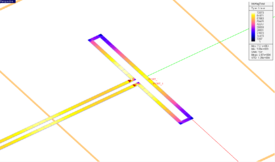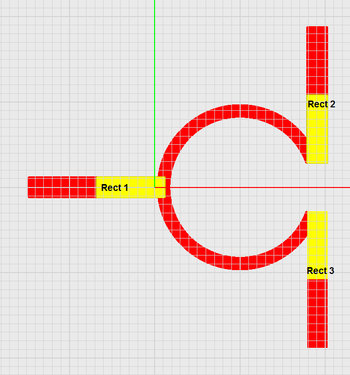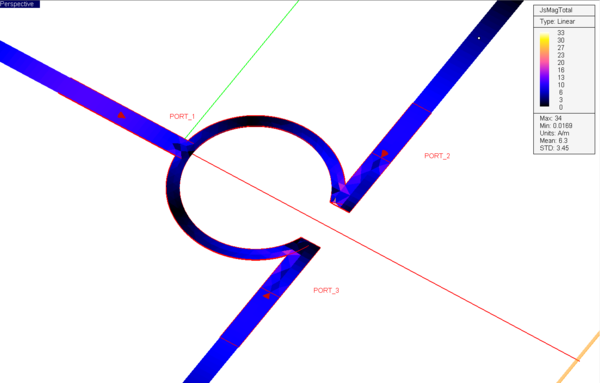Difference between revisions of "EM.Picasso Lesson 5: Modeling Periodic Frequency Selective Surfaces"
Kazem Sabet (Talk | contribs) |
Kazem Sabet (Talk | contribs) (→Running a Planar MoM Analysis) |
||
| Line 161: | Line 161: | ||
| − | Also, visualize the current distribution on the divider circuit. Note that the maximum current on Port 1 line is about 40A/m, while the maximum current values on the Port 2 and Port 3 lines are about 28V/m (40/√2 ≅ 28). | + | Also, visualize the current distribution on the divider circuit. Note that the maximum current on Port 1 line is about 40A/m, while the maximum current values on the Port 2 and Port 3 lines are about 28V/m as expected (40 / √2 ≅ 28). |
| − | + | ||
==Adding a Lumped Resistor== | ==Adding a Lumped Resistor== | ||
Revision as of 22:33, 27 October 2014
Contents
Objective:
To construct a CPW-fed folded slot antenna in EM.Cube’s Planar Module, analyze it and visualize its near and far field characteristics and parameterize the design and explore its variations.
What You Will Learn:
In this tutorial lesson you will introduce slot (PMC) traces to your physical struture. You will also define coupled ports to model coplanar waveguide (CPW) structures.
Getting Started
Open the EM.Cube application and switch to Planar Module. Start a new project with the following attributes:
- Name: PMOMLesson5
- Length Units: mm
- Frequency Units: GHz
- Center Frequency: 2.4GHz
- Bandwidth: 1GHz
- Number of Finite Substrate Layers: 1
- Layer Stack-up:
- Top Half-Space: Vacuum
- Middle Layer: ROGER RT/Duroid 5880, εr = 2.2, μr = 1, σ = σm = 0, thickness = 0.787mm
- Bottom Half-Space: Vacuum
Drawing the Divider Structure
Create a PEC group on the Navigation Tree and call it PEC_1. Draw six rectangle strip objects with dimensions and locations given in the table below:
Defining Sources, Assigning Ports & Examining the Planar MeshDefine three de-embedded source DS_1 (+X-directed), DS_2 (-Y-directed) and DS_3 (+Y-directed) for the three port lines Rect4, Rect5 and Rect6, respectively. Also, define a default "Port Definition" observable that assigns Ports 1, 2 and 3 to the three de-embedded source, respectively. Open the Planar Mesh Settings dialog and change the mesh density to 30 cells per effective wavelength. Generate and view the mesh of your planar structure. Note how the three line segments Rect1, Rect2 and Rect3 have merged with the circular arc-ring, and a consistent mesh has been generated.
Running a Planar MoM AnalysisRun a quick planar MoM analysis of your three-port power divider structure. At the end of the simulation, the following S-parameter values are reported in the Output Message Window:
S21(dB): -3.119946 S31(dB): -3.194342 S22(dB): -6.227977 S33(dB): -6.094034 S32(dB): -7.046050
Adding a Lumped ResistorNext, you will run add a lumped resistor between the two output ports of your power divider to complete the Wilkinson design. But first you need to draw a line segment between the two objects Rect2 and Rect3. Draw a new rectangle strip object
frequency sweep of your folded slot antenna to examine its frequency response and resonance behavior. Keep in mind that an adaptive frequency sweep does not generate current distribution plots or 3D radiation patterns at each frequency sample, but a uniform frequency sweep does. Therefore, first run a uniform frequency sweep with the following parameters: Start Frequency: 1.4GHz End Frequency: 2.0GHz Number of Frequency Samples: 13
Start Frequency: 1.4GHz End Frequency: 2.0GHz Min No. of Frequency Samples: 5 Max No. of Frequency Samples: 15 Convergence Criterion: 0.02
|














